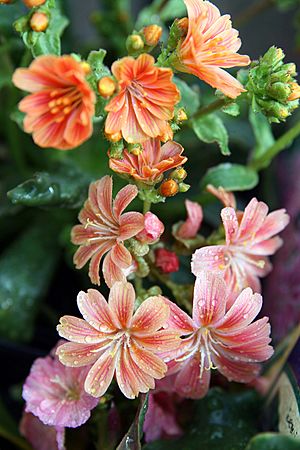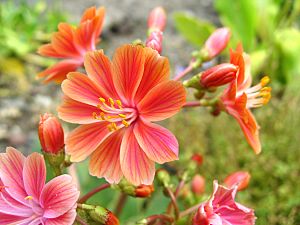Lewisia facts for kids
Quick facts for kids Lewisia |
|
|---|---|
 |
|
| Cultivated Lewisia cotyledon | |
| Scientific classification |
|
| Kingdom: | Plantae |
| Clade: | Tracheophytes |
| Clade: | Angiosperms |
| Clade: | Eudicots |
| Order: | Caryophyllales |
| Family: | Montiaceae |
| Genus: | Lewisia Pursh |
| Species | |
|
19, see text |
|
Lewisia is a type of plant named after an American explorer, Meriwether Lewis (1774-1809). He first saw these plants in 1806. Lewisia plants naturally grow on north-facing cliffs in western North America. Long ago, local Native Americans used to eat the roots of these plants. They also used the roots to help with sore throats.
Contents
What are Lewisia Plants Like?
Lewisia plants are perennial flowering plants. This means they live for more than two years. They are found in western North America, growing in rocky places from high mountains to lower areas like chaparral (shrublands), oak forests, and pine forests.
These plants have flowers that grow in a rosette shape, like a circular cluster of leaves. Their flowers come in many different colors! Some types, like Lewisia cotyledon, can grow up to about 0.5 meters (1.6 feet) tall and wide.
About half of the Lewisia species are deciduous. This means their leaves fall off in certain seasons, usually winter. The first Lewisia plant discovered, Lewisia rediviva, is deciduous. Lewisia longipetala is the only semi-deciduous type, meaning it loses some, but not all, of its leaves. Other species, like Lewisia cotyledon, are evergreen. This means they keep their leaves all year round.
How Lewisia Got Its Name
Meriwether Lewis, famous from the Lewis and Clark Expedition, was the first European or American to discover Lewisia plants. However, local Native Americans already knew the plant as bitterroot. Lewis found the plant in 1806 near Lolo Creek, in the mountains now called the Bitterroot Mountains. Later, a scientist named Frederick Traugott Pursh gave the plant its scientific name, Lewisia rediviva.
Different Kinds of Lewisia
There are nineteen different species (types) of Lewisia, plus several varieties. Here are some of them:
- Lewisia brachycalyx: Found in the United States (California, Arizona, Utah) and Mexico (Baja California).
- Lewisia cantelovii: Grows in the USA (California, Nevada).
- Lewisia columbiana (with different varieties): Found in Canada (British Columbia) and the USA (Washington, Oregon, Idaho, Montana).
- Lewisia congdonii: Grows in the USA (California).
- Lewisia cotyledon (with different varieties): Found in the USA (Oregon, California).
- Lewisia disepala: Grows in the USA (California).
- Lewisia glandulosa: Found in the USA (California).
- Lewisia kelloggii (with different varieties): Grows in the USA (California, Idaho).
- Lewisia leeana: Found in the USA (California, Oregon).
- Lewisia longipetala: Grows in the USA (California).
- Lewisia maguirei: Found in the USA (Nevada).
- Lewisia nevadensis: Grows in many US states, including Washington, Oregon, California, Nevada, Utah, Colorado, and New Mexico.
- Lewisia oppositifolia: Found in the USA (Oregon, California).
- Lewisia pygmaea: Grows in Canada (Yukon Territory, British Columbia) and many US states, including Alaska, Washington, Oregon, Idaho, and California.
- Lewisia rediviva (also known as Bitterroot): This is the state flower of Montana. It has different varieties and grows in Canada (British Columbia) and many US states like Montana, Washington, Oregon, and California.
- Lewisia sacajaweana: Found in the USA (Idaho).
- Lewisia serrata: Grows in the USA (California).
- Lewisia stebbinsii: Found in the USA (California).
- Lewisia triphylla: Grows in Canada (British Columbia) and many US states, including Washington, Oregon, Idaho, and California.
- Lewisia ×whiteae: This is a hybrid plant found in the USA (Oregon). It's a mix of Lewisia leeana and Lewisia cotyledon.
Where Do Lewisia Plants Grow?
Lewisia plants are naturally found in the western parts of North America. They often grow on north-facing cliffs. In these places, Lewisia plants have to deal with very extreme weather conditions.
How People Use Lewisia
All types of Lewisia plants can be eaten. The Lewisia rediviva plant has a large root that was an important food source for local Native Americans. Before eating, the root is peeled and then boiled or steamed. Cooking the root helps to make it less bitter.
Lewisia rediviva has also been used as medicine. Chewing the root was a way to help relieve a sore throat. It was also used to help new mothers produce milk.
For gardening, people often plant Lewisia species in rockeries. A rockery is a garden area with lots of rocks, which is similar to the plant's natural home. Rockeries also help the plants drain water well, which is important to stop their roots from rotting. Lewisia plants can also be grown in pots, but they still need good drainage and protection from too much wet weather.
See also
 In Spanish: Lewisia para niños
In Spanish: Lewisia para niños



